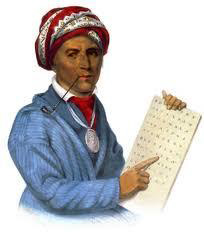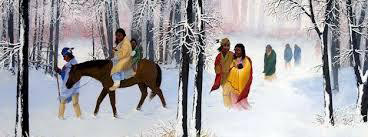Cherokee Winter
Stories
Presented by Roy Cook
Cherokee--more properly spelled Tsalagi--is an Iroquoian language with
an innovative written syllabary invented by a Cherokee scholar. Tsalagi
is spoken by about 22,000 people, primarily in Oklahoma and North Carolina.
Though it is one of the healthier Indian languages of North America and
the one in which the most literature being published, Tsalagi is still
in imperiled condition because of government policies as late as the fifties
which enforced the removal of Cherokee children from Tsalagi-speaking
homes, reducing the number of young Cherokees being raised bilingually
from 75% to less than 5% today.
People: 'Cherokee' is Creek for 'people with another language'. (It's
really amazing how white settlers always managed to learn some other tribe's
name for any group of Indians. They learned the Creek word for Cherokee,
but not the Creek word for themselves.) Anyway, our original name for
ourselves was Aniyunwiya.
When reading a Cherokee word written phonetically, remember these pronunciations:

- A as in
'father'
- E an 'a' sound, as in 'way'
- I an 'e' sound, as in 'bee'
- O as in 'oh'
- U as in 'ooh'
- V sounds like 'uh'
- Ts makes a 'j' sound
Some Cherokee Words
Greetings and Courtesies:
- Hello O si yo
- How are you? To hi tsu?
- Fine O s da
- And you? Ni hi na
- Okay Ho wa
- Thank you Wa do
- Yes vv ii
- No Thla
- I don't know Thla ya gwan ta
From 1887 to 1890
James Mooney, working with the Smithsonian Museum, lived among the Eastern
Band of Cherokee. He came to know, love and respect them, and was in reportedly,
known, loved and respected by the Cherokee, especially by an old medicine
man by the name of Swimmer. Mooney collected a remarkable large body of
material about Cherokee culture, history, myths and sacred formulas. His
book, Myths of the Cherokee and Sacred Formulas of the Cherokee is the
best source book for Cherokee myths, ceremonies and sacred formulas. Reading
from Mooney¡¦s work, one will occasionally notice some similarities
to myths and stories from western civilization. Some of these similarities
are due to the fact that the sustained contact between the whites and
Cherokees since the mid 1700's allowed many western ideas to filter into
the Cherokee stories. But most Cherokee stories seem to have well developed
long before any contact with European whites.
- The Cherokee, like
other native Americans, did not worship spirits and icons, but believed
in one Supreme Being. They lived in harmony with their natural environment.
It was their myths and sacred formulas, developed over thousands of years
and passed orally from generation to generation, which helped them to
do this. Myths may or may not have any bases in fact. But they become
institutionalized as "truth" and have a great influence in the
cultural behavior of individuals, groups and communities. They are used
to teach the young many of the important lessons of life. The Cherokee
chose special persons in special linages to pass on their oral traditions.
Great care was taken to maintain the purity of such traditions.
- Virtually every
aspect of the Cherokee life and the Cherokee environment had a story to
explain it. A Water Spider with black downy hair and red stripes on her
body brought fire to the Cherokee, after much frustrating effort. The
story of the origin of core (Selu) and game (Kana'ti) includes a reference
to a tribe of cannibals (Roasters or Anada' duntaski). Kana'ti, the father,
was the Lucky Hunter and Selu was his wife. Every disease was created
and put on the Cherokee man by the animals. This was a revenge for man
killing the animals. However, the plants, which were friendly to man,
decided to furnish a remedy to counteract the evil wrought by the vengeful
animals.
 -
The hummingbird frequently draws nectar from tobacco blooms. In Cherokee
mythology, it brought tobacco to the Cherokee. Unlike our modern age,
the Cherokee believed that tobacco had powerful medicinal qualities. The
Cherokee gave it credit for easing suffering by smoking it. It was smoked
at councils, which democratically debated the beginning of war, as well
at the councils which brought an end to war. It was smoked at the welcoming
of any distinguished visitor to the tribe; it was used to place on fires
to divine the future, according to the direction in which the wind blew
the smoke.
-
The hummingbird frequently draws nectar from tobacco blooms. In Cherokee
mythology, it brought tobacco to the Cherokee. Unlike our modern age,
the Cherokee believed that tobacco had powerful medicinal qualities. The
Cherokee gave it credit for easing suffering by smoking it. It was smoked
at councils, which democratically debated the beginning of war, as well
at the councils which brought an end to war. It was smoked at the welcoming
of any distinguished visitor to the tribe; it was used to place on fires
to divine the future, according to the direction in which the wind blew
the smoke.
- The Cherokee believed that the sun was a young woman who lived in the
East. The moon was her brother and lived in the west. One story related
how the Redbird was the daughter of the sun. Eclipses were believed to
be caused by a giant frog that lived in the sky and tried to swallow them.
The lightning and the rainbow were the dress of the sons of Thunder, who
lived far in the west above the sky vault. Several different Cherokee
stories exist to explain the stars. One was about a dog that stole corn
meal, and once discovered, was whipped. As the dog ran howling to his
home in the north, the meal scattered across the sky and made the Milky
Way. The Buzzard played an important role in Cherokee mythology. He made
the mountains and valleys with his wings. He was also important as a "doctor."
- The eagle was the great sacred bird to most Native American tribes,
as it was to the Cherokee. It played a prominent role in their ceremonies,
especially to those relating to war. The killing of an eagle to obtain
the prized feathers could only be done by a designated eagle killer, who
like other "professions" within the tribe, was specifically
chosen and trained for that purpose. The eagle killer was taught not only
how to kill an eagle, but also the "prescribed forms and the prayers
to be said afterwards in order to obtain pardon for the necessary sacrilege,
and thus ward off vengeance from the tribe." (Mooney, p.28l) Killing
an eagle out of season, late fall or winter, could cause a front to destroy
the corn and snakes to become doubly dangerous. Eagle songs were only
sung after the snakes had "gone to sleep for the winter." Only
great warriors or medicine men could wear the feathers.
- The Uktena played an important role in Cherokee mythology. Mooney wrote:

"Those
who know say that the Uktena is a great snake, as large around as a tree
trunk, with horns on its head, and a bright, blazing crest like a diamond
upon its forehead, and scales glittering like sparks of fire. It has rings
or spots of
color along its whole length, and can not be wounded except by shooting
in the seventh spot from the head, because under this spot are its heart
and its life. The blazing diamond is called Ulunsu'ti, "Transparent,'
and he who can win it may become the greatest wonder worker of the tribe,
but it is worth a man's life to attempt it, for whoever is seen by the
Uktena is so dazed by the bright light that he runs toward the snake instead
of trying to escape." (Mooney, p.297)
- Another important element in Cherokee mythology was the Nunne'hi, or
immortals, who lived throughout the highlands of the Cherokee nation.
A race of spirit people, they were invisible except when they wanted to
be seen, at which times they appeared to physically resemble the Cherokee.
Generally, they were friendly and frequently helped those who were in
need. Like the Cherokee, they were extremely fond of music and dancing.
Many of their townhouses were said to be on the high mountain balds, although
many stories associate them with the ancient mound of Nikwasi, near present
day Franklin North Carolina.
- Perhaps no Cherokee legend has been more enduring than the belief in
the Yunwi Tsunsdi', the Little People. About knee high to an adult, they
were well shaped and handsome, with long hair, which reaches the ground.
Considered to be wonder workers, like the Nunne'hi, they spent half their
time drumming and dancing. Helpful and kind hearted; they were especially
helpful to children, and frequently helped adults, unseen at night, at
such things as gathering corn.
Source: http://www.telliquah.com/cherokee.htm